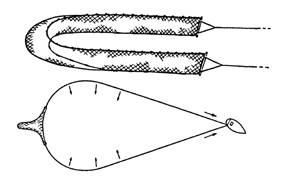Diagnosis: Large specimens of Dasyatis centroura are recognizable by their thorny tails, by the large size and wide spacing spacing of their mid-dorsal bucklers, and by the conspicuous tubercles or bucklers on the outer parts of their discs; in smaller specimens the large tubercles have not yet developed on the tail (Ref. 6902). It differs from Dasyatis sabina, D. guttata and Himantura schmardae in the shape of disc; it resembles Dasyatis say and D. americana in shape of disc, but it can be distinguished from D. say by the fact that the tail lacks any trace of a cutaneous fold above, and from D. americana by its much narrower ventral tailfold (Ref. 6902).
Description: A very large stingray; disc rhombic, the anterior margins forming a blunt angle (Ref. 6902, 39859, 81259). Dorsal surface entirely, but irregularly rough, with a mid-dorsal row of large thorny tubercles provided with striate bases and erect cusps; a few similar tubercles scattered over pectoral fins and head (Ref. 81259). Tail whip-like and strongly spinous, with numerous rows of small spines; tail with a short dorsal ridge behind the sting and a poorly developed ventral fold, which is long long, but quite low and not easily seen (Ref. 7251).
Colouration: Dorsal side dark brown to olivaceous-brown; the lower surface whitish, with or without dark pectoral margins; tail blackish behind the sting (Ref. 6902, 81259).
 Image not available
Image not available









